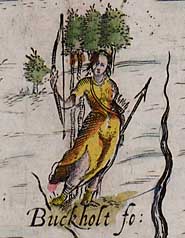Who we are

Further reading:
 'What is proposed and why is it important that this work is done?'
'What is proposed and why is it important that this work is done?'
 'How many forests survived into and through early modern times?'
'How many forests survived into and through early modern times?'
Forests and Chases in England and Wales to c. 1850:
Towards a Multidisciplinary Survey
The purpose of the project is to raise awareness of, and excite interest in, the proposal to conduct systematic groundwork towards a comprehensive, multi-disciplinary investigation of the medieval and post-medieval spatial, temporal, functional, and cultural survival and significance of the Forests and Chases of England and Wales. Here are some of the more important topics addressed by ourselves and other scholars involved in this research.
 Social and economic
Social and economic
![]() Aristocratic patronage and perquisites,
and their relationship to royal and aristocratic hunting;
Aristocratic patronage and perquisites,
and their relationship to royal and aristocratic hunting;
![]() Livelihood for the marginalised (as exemplified in
squatting, poor's woods and commons);
Livelihood for the marginalised (as exemplified in
squatting, poor's woods and commons);
![]() Swanimote
and other courts (among the oldest forms of local self-determination, crucial to recovering pre-modern communitas);
Swanimote
and other courts (among the oldest forms of local self-determination, crucial to recovering pre-modern communitas);
![]() Cultural
diversity, including religion (particularly Recusancy);
Cultural
diversity, including religion (particularly Recusancy);
![]() Demography,
including squatting, and economic linkages;
Demography,
including squatting, and economic linkages;
![]() Protest
and riot
Protest
and riot
 Ecological and environmental
Ecological and environmental
![]() Transitional
hunting landscapes (alongside developments in horse-breeding, -trading, and
-acing, and military theory and practice);
Transitional
hunting landscapes (alongside developments in horse-breeding, -trading, and
-acing, and military theory and practice);
![]() The
march of enclosure;
The
march of enclosure;
![]() Changes
in habits of 'hunting and gathering' as a major element of pre-industrial
agrarian and domestic regimes;
Changes
in habits of 'hunting and gathering' as a major element of pre-industrial
agrarian and domestic regimes;
![]() Fuel
demands, particularly as impacting on forest commons;
Fuel
demands, particularly as impacting on forest commons;
![]() The
spread of country house parkland as social expression and landscape component;
The
spread of country house parkland as social expression and landscape component;
![]() The
onset of 'scientific' forestry and state management;
The
onset of 'scientific' forestry and state management;
![]() Cartography
Cartography
 Scholarly and public policy
Scholarly and public policy
![]() Human
ecotypes as a model of discourse and analysis;
Human
ecotypes as a model of discourse and analysis;
![]() Modernity
and alternative frameworks for describing the survival of forest societies and
economy;
Modernity
and alternative frameworks for describing the survival of forest societies and
economy;
![]() Landscape
evaluation; and Countryside accecss and management;
Landscape
evaluation; and Countryside accecss and management;
![]() and
their relevance to conservation, sustainability, and renewable resources.
and
their relevance to conservation, sustainability, and renewable resources.
Data exists in documents, maps and plans, literature, and fieldwork, and it is proposed to disseminate the results to scholars and the wider public electronically as well as in print and through workshops, papers, and lectures.
The current partial state of knowledge about forests and chases in this period is typified by the need to ask 'How many forests survived into and through early modern times?' (For an introductory discussion, click on the title in the side panel.) A summary of the proposal's perceived significance, written for a general readership, is also accessible from the panel: 'What is proposed and why is it important that this work be done?'
